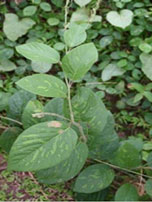SHAHEED KARTAR SINGH SARABHA AYURVEDIC MEDICAL COLLEGE & HOSPITAL
Affiliated to Guru Ravidas Ayurved University, Hoshiarpur Punjab
Affiliated to Guru Ravidas Ayurved University, Hoshiarpur Punjab

Botanical Name: Desmodium gangeticum DC
Family: Papilionaceae; Fabaceae
Introduction:
In south India Desmodium gangeticum used as ‘PRSNI PARNI’ , but in North India Uraria picta is used. Prsniparni is one of the important herbs according to Atharvaveda
Names in different Indian languages:
English : Salpan,salvan
Kannada : Nabiyalabune, nariyalavona
Malayalam : Orila
Sanskrit : Prsniparni,Prthakparni
Tamil : Orila
Telugu : gitanaram
Folk : Sarivan.
Synonyms:
Shaaliparni, Shaalaparni, Sthiraa, Somyaa, Guhaa, Triparni, Vidaarigandha, Anshumati.
Hedysarum gangeticum Linn.
Classification according to Charaka, Susrutha & Vagbhata:
Charaka : Angamarda prasamana, sothahara, Sandhäniya
Susrutha : Vidãrigandhadi, Haridrãdi
Vagbhata : Haridrãdi
Varieties & adulterants – (CV – controversy, AD – adulterants):
1. sãlaparni and Prniparni are used for each other.
2. Srgalavinna
3. U. lagopoides Dc.
4. Prsniparni visesa
5. U.hamosa
6. U. crinite
7. Desmodium nudiflorum
8. Uraria picta
Morphology:
It is an erect little-branched herb or undershrub, 1-1.5 m height .
Leaves- variable, 1-3 foliate, white, usually 10-15 cm long; leaflets 4-6, lanceolate or linear oblong, obtuse.
Flowers- in dense cylindrical racemes, purple coloured.
Fruits- pods, glabrous, turgid, 3-6, jointed, often whitish.
Seeds- 1-12, reniform, reddish (Flowers during rainy season and fruits in winter).
Habitat & Distribution:
All over India
Chemical composition:
gangetin, gangetinin, desmodin and several alkaloids.
Properties:
Rasa : Madhura, Tikta
Guna : Laghu, Snigdha
Virya : Usna
Vipaka : Madhura
Karma : Tridosahara, Grãhi, Vrsya, Dipaniyam,hridya
antipyretic, diuretic, astringent, anticatarrhal (used in post-natal care, chronic fever, cough, biliousness, vomiting), diuretic, anthelmintic, laxative and nervine tonic.
Part Used : Root
Dosage: Decoction 50-100 ml
Indications:
Jvara, svãsa, Raktãtisara, Trsnã, Chardi, Dãha, Asthibhagna.
Appetizer , insanity, psychosis, cough, bronchitis, dyspnoea; gout; bleeding piles; blood dysentery, acute diarrhoea., Fracture healing properties
Internal uses:
Central nervous ystem : As it is a nervine tonic and alleviates vata dosha, it, is used in vata disorders,
Digestive system : Being an appetizer. antidipsetic, deflatulent and astringent, it is used in flatulence, diarrhea and bleeding piles. Stomatitis is treated by local application of the paste of seeds and honey.
Circulatory system Cardiac tonic. haernostatic and reduces oedema, hence useful in heart diseases, blood disorders, vatarakta and oederna.
Respiratory system Expectorant. Useful in cough and dyspnoea.
Reproductive system : Aphrodisiac, useful in seminal debility.
Urinary system Diuretic, therefore effective in dysuria.
Temperature Febrifuge and refrigerant, hence it is used in fever and burning sensation.
Srotogamitwa :
Dosha :Tridoshashamak.
Dhatu : Shukra (aphrodisiac). asthi (Sandhana property), rakta ( anti diarrhoeal ). rasa (fever).
Mala : Purisha (laxative).
Important Yogas or Formations:
Dashamulãrista,Dasamüla katu trikãdi kvätha.
Therapeutic Uses:
(1) Asthibhagna- Powder of Prasniparni root is taken with meat-soup for three weeks will be helpful in the reunion (B.P.)
(2) Vatarakta- Prasniparni is cooked in goat’s milk and used with honey and sugar (S.S.Ci.5)
(3) Raktätisara- Liquid gruel (Peyä) prepared with Prasniparni is useful (C.S.Su.2)
